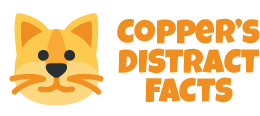Headbutts and Tail Rubs
Cats have scent glands located at different spots on their bodies, like the tops of their heads, their cheeks, and their tails. A cat’s scent gland is an organ that releases a chemical called a pheromone. Humans can’t see or smell those pheromones, but cats can easily detect their own scent as well as the scents of any other cats who have been around.
Our feline friends use their scent glands to leave their own personal smell on the humans, objects, and other cats that they encounter on a regular basis. Smell helps them to recognize familiar people and places, and it’s one more way that cats communicate, along with their verbalizations and body language.
So, when a cat headbutts you, rubs its tail against you, or slides its cheek across the corner of your wall, it’s saying it owns you and all your possessions. It’s probably also telling you that it loves you because nothing says I love you like, “I just sprayed some invisible smelly stuff on you.”

When you look, you see.
The technical term for what most of us call headbutting from cats is actually “bunting” or “head bunting.” If you want to see head bunting for yourself, the best thing to do is to get a cat to appoint you as its friend.
Keep in mind that this may require you to spend a lot of time picking up things that have been swatted off shelves, repairing shredded furniture, fixing documents that you were typing before the cat spread out on your keyboard, and of course, cleaning something called a “litter box.” It is all very much worth it though, and you will soon have a faithful friend spraying invisible smelly stuff on you day and night.

Hoping to sniff out more details about cats and their scent glands?
There are lots of great books and videos available for you to learn everything there is to know about cats. I’ve shared a few already on some of Copper’s other Distract Facts on poofy tails and cat chatter. Below are just a few more that you might enjoy!
Kids, remember to ask a parent, teacher, or librarian for help whenever you are looking for books or using the Internet. I always try to make sure to share kid-friendly books and resources, but websites are changing all the time, so always check with an adult first.
- PetMD has a great article all about what it means to get a head bump from your feline and it even points out that cats will sometimes head bunt their dog housemates! I don’t think Yap would stop barking long enough for Copper to give that a try. https://www.petmd.com/cat/behavior/cat-head-butting-what-does-it-mean
- The Complete Cat Breed Book by DK has an entire section on cat communication, with info on how cats rub their humans to mark everyone as part of their “gang” and a cool chart of how to read ten different types of tail signals. It’s a great book to dive into the world of cats and includes photos and information on over 50 different breeds. Check with your librarian for a copy or ask an adult if they’d like to get a copy to keep at home. I’ve included a link here to help them find the book at a local book shop: https://bookstorelink.com/9781465408518
- In another article from PetMD, vets break down what it means when a cat rubs its head, cheek, or tail against you. If the cat is meeting someone for the first time, it might just be their way of inspecting that person, not necessarily a gesture of friendship. https://www.petmd.com/cat/behavior/cat-behavior-why-do-cats-rub-against-you
